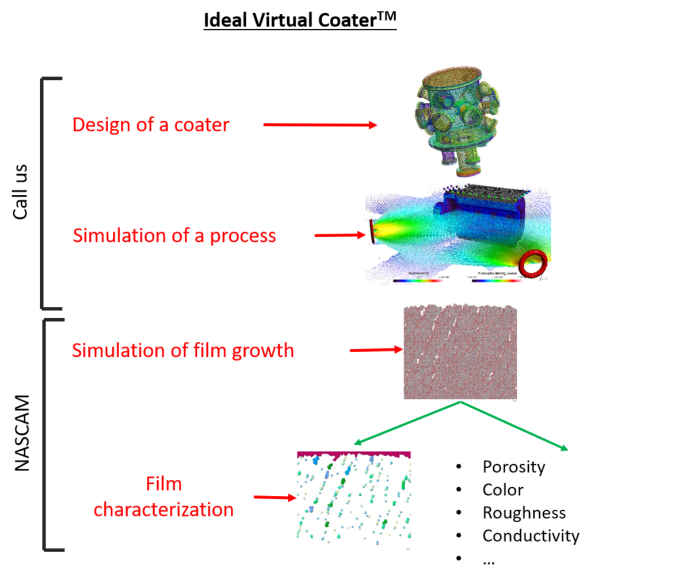Virtual Coater (NASCAM)
is a software suite to simulate the deposition, surface diffusion, nucleation, film growth, evolution of surface structures, and evaluation of their physical properties.
It is based on kinetic Monte Carlo method, and allows the deposition of millions of atoms in short time (< day).
It allows to mimic film growth based on vacuum deposition methods among others.
Within the framework of a virtual coater (see right), the user defines the condensing species as well as their energy and angular distributions. Those can be found in litterature or evaluated analytically or computed by using plasma simulation. ICS can help for that (contact us).
The film is then grown and the user can analyse its properties thanks to a friendly GUI interface.
NASCAM can be used to:
-
Complete, interpret, critically analyse and synthesise new and complex information from experimental findings (laboratory or industry).
-
Assess product quality in coater upscaling process.
-
Illustrate courses on nanotechnology, plasma deposition, thin film growth ...
-
...

V 4.8.X
(Current version)
-
Windows OS, integrated GUI
-
1D, 2D, 3D (substrate and deposition)
-
Two types of structure: cubic and hexagonal
-
Multilayers
-
Simulation of metal and reactive deposition
-
Surface diffusion based on fixed list of thermally activated events
-
Five deposition fluxes per layer: two metallics, two reactives and one neutral. Combination of Me and Me+, and R and R+, and Ar+ is possible
-
Energy and momentum transfer from incident fluxes to the substrate or a growing film
-
Resputtering
-
Rotating and tilting substrate while deposition
-
Deposition through a mask
-
Improved plugins (require NASCAM 4.8.X and later)
-
Commercial software
-
Annual proprietary software licence
V 5
(For ICS use, service and future release)
-
Windows OS, integrated new GUI
-
1D, 2D and full 3D (substrate and deposition)
-
Numerous crystal types: orthorhombic (primitive, face-centered, body centered), hexagonal, triclinic, amorphous, user defined, poly-crystals
-
Multilayers
-
Unlimited number of condensing species per layer (neutral, ions and molecules)
-
Standard and user-defined surface physico-chemical reactions
-
Surface diffusion based on modular list of thermally activated events
-
Advanced energy and momentum transfer model for very high energetic species
-
Resputtering and re-evaporation
-
Rotating and tilting while deposition
-
Deposition through a mask
-
Advanced plugin (e.g. FDTD)
-
Commercial software